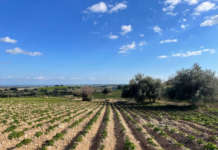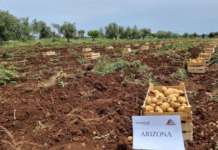Un mercato dall’andamento globale positivo e in grande evoluzione, con uno scenario competitivo che sta rapidamente cambiando e una filiera chiamata a rispondere a sfide cogenti, prima fra tutti quella di coniugare innovazione e sostenibilità. È questo, per sommi capi, lo scenario del settore mondiale delle fragole, così com’è stato delineato e approfondito dagli esperti riuniti a Policoro durante un workshop organizzato da Nova Siri Genetics, azienda specializzata nell’attività di ricerca e sperimentazione di nuove varietà di fragole e piccoli frutti. Il mondo delle fragole vive una fase favorevole: rispetto al triennio 2011-2013, nel periodo 2019-2021 il consumo apparente è cresciuto quasi del 30%, in particolare al di fuori della Ue dove peraltro si concentrano l’88% dei consumi. Nello stesso periodo sono aumentate del 16% le superfici coltivate, del 30% i volumi di produzione e del 12% la resa (23 tons/ha), arrivando a 391mila ettari e oltre 9 milioni di tonnellate. Ma, a livello di macro aree, l’andamento non è stato omogeneo: nella Ue a 27 c’è stata una crescita accentuata della produttività (+32%), che resta comunque inferiore a quella media del settore, ma un calo delle superfici. Al contrario, nel resto del mondo sono state produzione e superfici a crescere sopra media. La conferma come quella della fragola sia realmente una coltura globale, su cui stanno investendo molti paesi. Non necessariamente quelli che hanno sempre dominato il mercato.
L’analisi delle dinamiche produttive per paese mostra che la leader mondiale, la Cina, ha aumentato di quasi il 50% il raccolto mentre il numero due, gli Usa, lo hanno ridotto del 15%, com’è accaduto all’Italia, che però si colloca al 15esimo posto del rank globale. Sono i competitor giovani a crescere, e molto, come Messico (+102%), Turchia (+66%), Egitto (+95%), Marocco (+20%) e Grecia (+83%). Ma anche la Spagna, leader nella Ue, avanza di un 14%. Dunque, è soprattutto il bacino del Mediterraneo a conquistare spazio, con uno share a livello globale arrivato al 19%. Anche il commercio internazionale è vivace: l’export segna un +15% a volume e il prezzo medio un +32%, sempre rispetto al triennio 2011-13. E le performance migliori sono quelle dei paesi extra Ue (rispettivamente +28% e +67%), in particolare Messico e Turchia, con l’agglomerato Messico+Usa che raggiunge la questa incidenza a volume sull’export (31%) della leader, la Spagna.
Ma dove finiscono tutte queste fragole? I maggiori importatori sono gli Stati Uniti, che, rispetto al triennio 2011-2013, hanno comprato il 49% di prodotto in più. Import in forte espansione anche in paesi con consumi consolidati (come Germania e Gran Bretagna), ma anche in grandi produttori come la Spagna (+146%). Dinamiche che aiutano a ricostruire le strategie dei paesi del Mediterraneo, confermata anche dall’analisi dell’evoluzione del prezzo medio delle fragole esportate, con il Marocco che quasi lo raddoppia (+94%), la Spagna che ottiene un +16% e l’Italia un +24%. A quest’evoluzione del pricing si affianca quella della programmazione dell’offerta, con il Marocco che apre la stagione (59% della produzione tra febbraio e marzo), l’Italia che si inserisce subito dopo (60% in marzo e aprile) e la Spagna che arriva da ultima (76% in aprile-maggio). Confrontando i profili competitivi di questi tre paesi emerge che la Spagna ha una totale autosufficienza produttiva, una fortissima propensione all’export e una crescente vocazione all’import. Invece l’Italia non è autosufficiente quanto a produzione di fragola, ha una bassa vocazione all’export e risulta, quindi, un importatore netto. Infine il Marocco è autosufficiente a livello produttivo e una discreta propensione all’export, sebbene in calo, che ne fa un esportatore netto. Tre profili non concorrenti ma complementari, che potrebbero dar luogo a sinergie interessanti per rafforzare il ruolo del bacino del Mediterraneo nel mercato mondiale delle fragole. •
Evolution of the strawberry market
Careful planning of the offer is important to support the growth of exports
A market with a positive global trend in great evolution, with a competitive scenario that is rapidly changing and a supply chain called to respond to mandatory challenges, first of all that of combining innovation and sustainability. This is, in summary, the scenario of the global strawberry sector, as it was outlined and analyzed in depth by the experts gathered in Policoro during a workshop organized by Nova Siri Genetics, company specialized in research and experimentation of new varieties of strawberry and small fruits.
The world of strawberries is experiencing a favourable phase: compared to the three-year period 2011-2013, apparent consumption grew by almost 30% in the period 2019-2021, especially outside the EU, where 88% of consumption is concentrated. In the same period, cultivated areas increased by 16%, production volumes by 30%, and yield by 12% (23 tonnes/ha), reaching 391,000 hectares and over 9 million tonnes. But, in terms of macro areas, the trend was not homogeneous: in the EU-27 there was marked growth in productivity (+32%), which is still lower than the average for the sector, but a decrease in surfaces. Conversely, in the rest of the world, production and surfaces grew above average. This confirms that strawberries are truly a global crop, in which many Countries are investing; not necessarily the ones that have always dominated the market.
The analysis of the production dynamics by Country shows that the world leader, China, has increased its harvest by almost 50%, while the number two, the USA, has reduced it by 15%, as happened to Italy, which however stands 15th in the global rank. Young competitors, such as Mexico (+102%), Turkey (+66%), Egypt (+95%), Morocco (+20%), and Greece (+83%) are significantly growing. But even Spain, the leader in the EU, grew by 14%. Therefore, it is above all the Mediterranean basin that is conquering space, with a global share of 19%.
International trade, too, is lively: exports mark +15% in volume and the average price +32%, again compared to the three-year period 2011-13. And the best performances are those of non-EU Countries (+28% and +67% respectively), in particular Mexico and Turkey, with Mexico+USA reaching this result in volume on exports (31%) compared to the leading Country, Spain.
But where do all these strawberries go? The major importers are the United States, which, compared to the three-year period 2011-2013, bought 49% more product. Strongly expanding imports were recorded in Countries with consolidated consumption (such as Germany and Great Britain), too, but also for such large producers as Spain (+146%). These dynamics help reconstruct the strategies of the Mediterranean Countries, also confirmed by the analysis of the evolution of the average price of exported strawberries, with Morocco almost doubling it (+94%), Spain achieving +16%, and Italy +24%. This evolution of pricing is accompanied by that of planning of the offer, with Morocco opening the season (59% of production between February and March), Italy immediately after (60% in March and April), and Spain that comes last (76% in April-May).
By comparing the competitive profiles of these three Countries, it emerges that Spain has total productive self-sufficiency, very strong propensity to export, and growing vocation to import. Instead, Italy is not self-sufficient as for strawberry production, has low export vocation, and is therefore a net importer. Finally, Morocco is self-sufficient in terms of production and has a discrete propensity to export, albeit declining, which makes it a net exporter. Three non-competing but complementary profiles, which could give rise to interesting synergies to strengthen the role of the Mediterranean basin in the world strawberry market.










